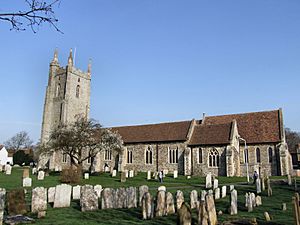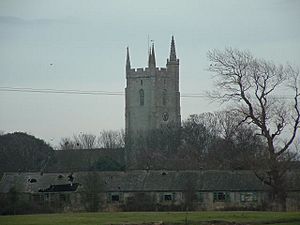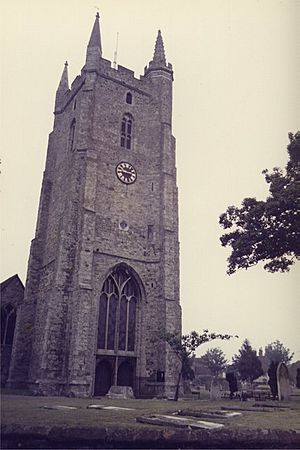All Saints Church, Lydd facts for kids
Quick facts for kids All Saints' Church |
|
|---|---|

All Saints' Church
|
|
| Lua error in Module:Location_map at line 420: attempt to index field 'wikibase' (a nil value). | |
| Location | Lydd, Kent |
| Country | England |
| Denomination | Church of England |
| History | |
| Status | Parish church |
| Founded | 5th Century |
| Dedication | All Saints |
| Architecture | |
| Functional status | Active |
| Heritage designation | Grade I |
| Designated | 28 November 1950 |
| Architectural type | Church |
| Administration | |
| Parish | Lydd |
| Deanery | Romney and Tenterden |
| Archdeaconry | Ashford |
| Diocese | Diocese of Canterbury |
| Province | Province of Canterbury |
All Saints' Church, also known as Lydd Church, is a very old and important church in Lydd, Kent, England. Some people even call it "The Cathedral on the Marsh" because it's so big! It's the longest parish church in Kent, stretching about 199 feet. Its tall tower reaches 132 feet into the sky, making it one of the tallest in the county.
This church is super old! Parts of it might have been built way back in the 5th century by the Romans and Britons. Most of what you see today was built in the Middle Ages. In the 15th century, it was a busy place, used by local groups and could hold 1,000 people. The church was badly damaged during World War II but was later fixed up. Today, it's a special building called a Grade I listed building.
Contents
History of All Saints' Church
For a long time, people thought this church was built by the Saxons. But newer studies show that the oldest part was built in the late 5th century. This means it might have been built by the Romans and Britons who lived there before the Saxons. It seems to have been a small basilica, which was a type of public building in Roman times.
Church Groups and Records
In the 15th century, many groups of local people, called Fraternities or Guilds, were connected to the church. Each group had its own services in different parts of the church. They would meet at an altar dedicated to their favorite saint. These groups helped keep a light burning in front of the altar or saint's image.
Some of the groups were named after saints like the Holy Trinity, All Saints, St. James, St. Peter, St. Mary, and St. George. Later, more groups were added, including St. Barbara and St. Nicholas. The church started keeping records of christenings and marriages in 1542. Records for burials began a little earlier, in 1539.
Changes Over Time
The inside of the church was updated in the 18th century. Old box pews were replaced with new oak pews. This allowed the church to seat up to 1,000 people.
All Saints' Church was heavily damaged during World War II. In 1940, a bomb hit the chancel, which is the part of the church near the altar. After the war, this part was rebuilt. One famous person who was a rector (a type of priest) here was Thomas Wolsey. He later became a very important Cardinal. However, he probably never actually visited the church.
On November 28, 1950, the church was officially named a Grade I listed building. This means it's a very important historical building that needs to be protected.
Church Design and Features
All Saints' Church is the longest parish church in Kent, measuring about 199 feet. It's built from stone and shows three different styles of English Gothic architecture:
- Early English
- Decorated
- Perpendicular
The church has a tiled roof. During the reigns of King Edward IV and King Richard III, new pews and a new roof were added to the main part of the church, called the nave.
The Tall Tower
The west tower of the church is 132 feet tall. This makes it one of the tallest towers in Kent! It has a beautiful set of eight bells. These bells were remade in 1926 from an older set of five bells from the 17th century. The tower was built between 1435 and 1450. It has a special top edge called crenellation with four decorative points called crockets.
The roof of the nave has strong wooden beams and decorative pieces.
Inside the Church
Inside the church, there used to be a chapel dedicated to St. Mary. There was also an altar and a chapel for St. John the Baptist. Other altars were dedicated to St. Peter, the Holy Trinity, and St. James. A window showing the Seven Sacraments was given to the church in 1476.
There are 17 special monumental brasses hidden under the carpet in the nave. These are engraved metal plates that remember people who have passed away. One brass from 1430 remembers the ancient Godfrey family of Lydd. There's also a bust of a Godfrey family member on the north wall of the chancel.
In 1611, the church was decorated with paintings and writings. Around 1428, new organs were bought for the church. They were repaired 26 years later. The church also has a 16th-century memorial for Thomas Godfrey. You can also see a statue of Sir Walter de Meryl, who was a local lord. Another interesting piece is a round marble carving by a famous artist named John Flaxman. It's dedicated to Anne Russell and her son.
Churchyard and Surroundings
The oldest tomb in the churchyard belongs to the Strugell family and dates back to 1551. Many sailors are buried in the churchyard. They were victims of the rough seas along this dangerous coast. Six sailors drowned when their ship, the "Northfleet," sank in January 1873. Also buried here is Tom Edgar, who sailed with Captain Cook in 1779.
The church tower looks over an old holm oak tree. On top of this tree, you can often see heron nests.



